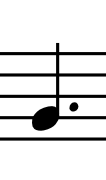Note Values
Every note placed on the staff needs to be assigned a rhythmic value. The sum of the note values in a measure cannot exceed the Time Signature's beat declaration. A note ultimately tells you two things. It tells you what note you need to play and when and how long you should play that note. This is one of the reasons reading music in standard notation is more difficult than tablature. If you want to get serious with music though you will need to understand the various note values. On guitar this is important when strumming as well since strumming is all about rhythm.
Parts of a Note
When you write a note on the staff it can contain different pieces of information. Most of the note syntax has to do with it's specific rhythmic value. The valid components of a note are the note head, the stem and the flag or beam. A basic rule of thumb is "The more ink it takes to write the note, the shorter it's rhythmic duration is".
Below shows the different possible pieces of a note in standard notation.
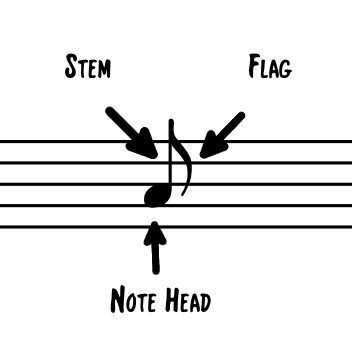
Note Names and Durations
The table below shows most of the common note values. The durations below are standard values in relation to the beat and it's subdivisions. Triplets are not shown here and will be discussed in a separate lesson.
| Whole Note | 4 beats | A whole note has no stem and the note head is not filled in. |  |
| Half Note | 2 beats | A half note has a stem and the note head is not filled in. |  |
| Quarter Note | 1 beat | A quarter note has a stem and the note head is filled in. |  |
| Eighth Note | 1/2 beat | An eighth note has a stem and the note head is filled in and it has a flag or is beamed to other eighth notes as seen in this example. | 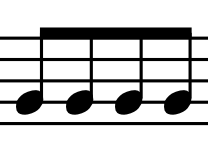 |
| Sixteenth Note | 1/4 beat | A sixteenth note has a stem and the note head is filled in and it has a double flag or is double beamed to other sixteenth notes as seen in this example. | 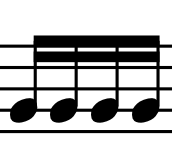 |
Dotted Notes
If you place a small dot after the note, the dot adjusts the note duration from the values listed in the table above. You can place a dot after any of the previous notes. When you dot the note it increases the note value by one and a half it's original value. So if you have a half note that is two beats and you dot it, it becomes a value of three beats. 2 x 1.5 = 3.
Below is an example of a dotted half note where it gets a duration of three beats
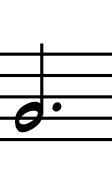
Below is an example of a dotted quarter note. A quarter note gets 1 beat so a dotted quarter note is 1 x 1.5 = 1.5 beats or 3 eighth notes.
